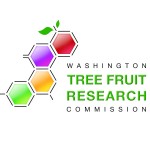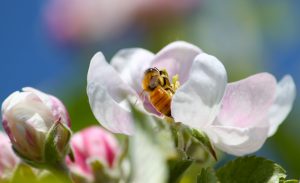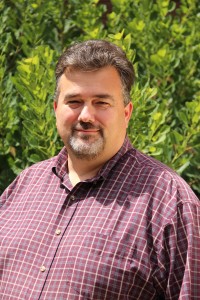Written by: Tim Lawrence, WSU Extension, Island County; and Tory Schmidt, WA Tree Fruit Research Commission. Written March 23, 2018. Last update April 1, 2022.
Most people in agriculture understand the crucial role cultivated honey bees play in the production of specialty crops across the country, particularly in the tree nut and tree fruit industries of the West Coast. Without a large influx of these key pollinators every spring, Washington growers would set only a small fraction of the apples, pears, cherries, and other stone fruit necessary for commercial viability. Historic advice on managing honey bees from experts like Free, Mayer, and Delaplane is still largely relevant, but with today’s modern production systems, a new generation of growers, and continually advancing research, we offer these updated guidelines for current best management practices for orchardists renting commercial bees.
Before considering specific issues about using hives in orchards, some understanding of basic honey bee biology can be instructive. A healthy colony in the spring and summer typically consists of a queen bee, several hundred drones (males), and many thousands of workers (females); the queen lays the eggs, the drones’ principle role is to mate with virgin queens, and the workers perform a complex, but well-organized myriad of tasks including: foraging for pollen, nectar, and water; caring for the larvae and queen; producing honey; maintaining the hive environment; cleaning the hive; and protecting the hive. All members of the colony are crucial, but it is the activity of the worker bees that is of greatest interest to growers who want their crops to be pollinated. Maintaining a healthy pollinator agro-eco environment is one of the most important things growers can do to ensure optimal pollination.
If the hive is healthy and presented with an opportunity for good foraging (i.e. an abundant nearby pollen, nectar, and water), the colony will respond with more efficient foraging activity, which ultimately benefits both the colony and the orchardist. As more pollen and nectar is brought in to the hive, the queen is stimulated to lay more eggs; in response to the nutritional demands of more larvae, the worker bees are stimulated to collect even more pollen and nectar. Colonies under stress, however, will not forage as effectively, resulting in reduced fruit set. In addition to things like pest and diseases, stress can include exposure to pesticides, nutritional deficiencies and lack of clean water. It is very much in the grower’s interests, therefore, to minimize stress on the hives regarding factors they can control such as providing a diversity of floral sources, ensuring adequate supplies of clean water, and limiting pesticide exposure. These simple steps will increase the likelihood that as many as a third of the population of a healthy and productive hive will be dispatched to forage the bloom in your orchard.
Bear in mind that foraging bees don’t really care if you produce a lot of fruit, they’re only interested in gathering the resources to support the nutritional needs of the colony. Bees need a diversity of pollen and nectar to meet these nutritional requirements and will change their foraging behavior to satisfy deficiencies. Not all pollen or nectar contain all of the essential nutrients, and protein content of pollen can vary widely. Bees prefer work within a half mile of the hive but will fly up to 6 miles to forage in search of what they need. The more time and energy bees expend in lengthy flights to meet nutritional demands, the fewer the number of available bees to visit your fruit trees. Growers can do themselves a favor by making sure their bees don’t have to work too hard to find fresh water and a variety of flowers to provide diverse sources of carbohydrates (nectar) and protein (pollen) and other essential nutrients to fuel the hive.
The cultivation of a range of flowering plants such as borage, sunflower, poppy, clover, alfalfa, and even dandelions in and around your orchard will also encourage the development of native pollinator populations including wild bees. These alternative species often provide important supplementation to pollination services from honey bees because they often forage in cooler, windier conditions and work orchard rows in different patterns than your rented bees. Even better, research has shown that the presence of competing foragers alters honey bee foraging behavior, increasing activity between rows and within tree canopies.
Highlights of Current Bee Research
- Most experts point to the Varroa destructor mite as the primary cause of dwindling honey bee populations; ongoing research projects suggest that overwintering of hives in controlled atmosphere cold storage (namely with high CO2 concentrations) can kill off the mites without harming the bees (https://www.goodfruit.com/bees-may-do-better-being-kept-in-the-dark/)
- WSU scientists have been rearing bees bred in part from semen collected from wild bees in the Tien Shan mountains of Kazakhstan, the home of vast forests of wild apple tree species; this project promotes the genetic diversity of germplasm available to bee breeders, potentially producing new populations of pollinators that may offer some advantages to tree fruit growers (http://www.goodfruit.com/a-new-old-bee/)
- Work led by USDA-ARS scientists in Utah indicates that Osmia lignaria (Blue Orchard Bee or Orchard Mason Bee) can be established in commercial orchards, creating a native population of pollinators that work in cold, windy conditions and help supplement pollination services provided by rented Italian honey bees (https://www.goodfruit.com/a-better-bee-blue-orchard-bees-show-promise-as-pollinators)
- Work conducted at Michigan State University and the University of California has demonstrated that providing a diversity of floral sources can increase the diversity of pollinators within an orchard; this diversity of pollinators changes the foraging behavior of honey bees to the benefit of the grower
- Research from the United Kingdom, Israel, and elsewhere has demonstrated the need for a diversity of floral sources to meet the nutritional demands for bees; this type of research is critical to ensure the optimization of pollination activities of bees
- Modeling work by USDA-ARS scientists in Arizona suggests that as much as 80-90% of fruit set in apple and almond orchards occurs not because a single bee picks up pollen from a pollinizer (i.e. crabapple) and directly deposits it on the flower of the main crop (i.e. apple), but due to pollen transfer that occurs within the hive itself when bees which have been working flowers of diverse plant species rub against each other
- An ongoing project involving scientists from WSU, USDA-ARS, and the WA Tree Fruit Research Commission seeks to develop a predictive model of honey bee foraging activity under various weather conditions (sunlight, temperature, wind, precipitation) as an indicator of potential fruit set; this model is currently being evaluated by industry beta-testers on WSU’s Decision Aids System (https://decisionaid.systems/
Recommendations
With this background, here are some specific recommendations and information regarding the use of rented honey bee hives to pollinate tree fruit orchards in WA:
Timing: For most crops, deploy your hives as bloom is starting to open, sometime between “popcorn” stage and 10% open bloom; for crops that are not as attractive to bees (i.e. pear), delaying until 25% open bloom may be helpful in preventing bees from finding other crops to work. Hives should be removed when the orchard no longer has viable pollen, and/or all flowers have dried up; move hives only between dusk and dawn, when foraging activity is minimal.
Hive clustering and placement: Place hives in an open, warm, sunny area with good air flow for optimal foraging. Hives may be clustered in drops of 12-20 hives (3-5 pallets). Depending on the crop, using one to two hives per acre is adequate for most orchards. Distribute hives throughout the orchard bearing in mind that bees prefer to work within ½ mile of their hive.
Water: Bees need a lot of water to help regulate the temperature and humidity within the hive. Pans of water with burlap draped over the edge to prevent drowning can be very effective if the water is refreshed every few days. Dribbling sprinklers or drip emitters can also be effective provided they are not carrying any chemicals or fertilizers. Bees may also use standing water, so growers should be careful not to leave puddles when mixing chemicals for sprays or fertilizing.
Dandelions: As mentioned above, dandelions provide an important source of nectar and pollen to support hive health, so growers should consider leaving them in the field. In fact, cultivation of a flowering cover crop in or near the orchard may actually promote fruit set. Be careful with application of pesticides in these areas; only when pesticides known to be harmful to bees will be sprayed to the cover crop should these areas be mowed prior to placing bee hives.
Assessing hive health: Counting bees coming in and out of the hive may be instructive but doesn’t give a full picture. The surest method is to crack open a hive and examine individual frames – a healthy hive should have bees covering of 5 or 6 frames in both the top and bottom boxes. You should also see evidence of developing brood (medium brown cell coverings) in the frames. If you are not comfortable opening hives, ask your beekeeper to do so; a random sampling of 5-10% of your hives should provide a good indicator of the quality of your bees.
Pesticide concerns: Always follow label directions; if there is any warning about bee toxicity, do not use that material when bees are present. Broad spectrum insecticides such as organophosphates, carbamates, neonicotinoids, and many pyrethroids are known to be very hard on bee colonies. If possible, it is best not to spray or chemigate with any materials at all while hives are in your orchard, but if you must, try to do so at night or early in the morning before bees become active.
Pollen supplements/foraging stimulants: Foraging stimulants have mixed reviews with some support for the use of brood pheromone to increase seed set in carrots, but in blueberry and tree fruits, use of nasonov pheromone has shown little or no benefit. Orchards designed with adequately distributed compatible pollinizers in a pollinator-friendly agro-eco system design should not need any pollen supplement, either in the form of pollen inserts or floral bouquets.
Human safety around hives: Generally speaking, honey bees have jobs to do and aren’t too concerned about what humans are doing around them until those people present a threat to the colony. Move calmly and slowly around the hives and try to approach from the sides if necessary. Avoid wearing dark colors such as red or black and refrain from using noisy equipment like chain saws and weed eaters around the hive. The purchase of a bee veil might be a good investment if you need to work near the hive, or even better, a smoker – a few puffs of white smoke can help calm bees considerably. Finally, remember that angry bees can fly faster than you can run in a straight line, so try ducking around trees and bushes to escape the worker bees defending their colony.
Contact
Project Manager
Washington Tree Fruit Research Commission
1719 Springwater Ave.
Wenatchee, WA 98801 USA
Office: (509) 665-8271 x4
Mobile: (509) 669-3903
Email: tory@treefruitresearch.com
Web: www.treefruitresearch.com
Fruit Matters articles may only be republished with prior author permission © Washington State University. Reprint articles with permission must include: Originally published by Washington State Tree Fruit Extension Fruit Matters at treefruit.wsu.edu and a link to the original article.


